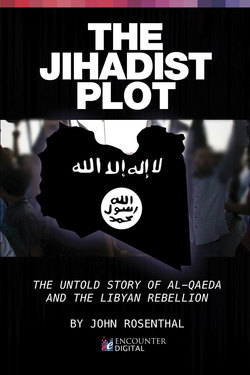Читать книгу The Jihadist Plot - John Rosenthal - Страница 8
На сайте Литреса книга снята с продажи.
ОглавлениеChapter 3
Black Flags in Benghazi—and Beyond
On October 23, 2011, three days after the fall of Sirte and the murder of Muammar al-Qaddafi, National Transitional Council chair Mustafa Abdul Jalil officially declared the “liberation” of Libya at a ceremony in Benghazi. Within days of Jalil’s declaration, the black flag of al-Qaeda was spotted flying atop the Benghazi courthouse: the symbolic cradle of the anti-Qaddafi rebellion. British Prime Minister David Cameron and then French President Nicolas Sarkozy had feted the Libyan rebellion from the steps of the courthouse barely five weeks earlier. The appearance of the flag provoked surprise and consternation among American commentators. But, as will be seen further on, it should not have come as any surprise.
Defenders of the rebellion attempted to minimize the significance of the flag sighting, insisting that the hoisting of the flag had been an isolated incident or even suggesting that pictures of it had been photo-shopped. But the flag atop the courthouse was not the only al-Qaeda flag to be seen in Benghazi in the week after Libya’s “liberation.” As demonstrated by photographic and video evidence posted on Arabic-language Internet forums and YouTube pages, the Benghazi waterfront had in fact been awash with al-Qaeda flags in those days.
Astonishingly, some of the photos even made their way into the American press—apparently without, however, the responsible editors realizing what the photos show. Thus one such photo appeared in the New York Times accompanied merely by the following—relatively innocuous—caption: “Benghazi on Friday, several hundred men rallied to demand the application of Islamic law, or Shariah, in Libya. That could clear the way for polygamy.”1 No mention was made—much less explanation given—for the al-Qaeda flags that can clearly be seen fluttering over the demonstrators’ heads.
October 2011: Demonstrators with al-Qaeda flags on the Benghazi waterfront. (© REUTERS/Esam Al-Fetori)
Video of the same demonstration uploaded by local users onto Arabic language YouTube pages shows at least hundreds, if not indeed thousands, of men gathered on the Benghazi waterfront with al-Qaeda flags spread densely throughout the crowd. The videos were posted by Tawasul and Tadhamun [Solidarity]: two online media that sprung up in Benghazi in the wake of the rebellion.2 The demonstration took place on October 28th: five days after the proclaimed “liberation” of Libya.
The flag flown by the demonstrators on the Benghazi waterfront is, more precisely, the flag made famous by the late Abu Musab al-Zarqawi’s al-Qaeda in Iraq, which was originally known as Jama’at al-Tawhid wal-Jihad: the “Monotheism and Jihad Group.” Al-Zarqawi pledged fealty to Osama bin Laden and officially declared his group an al-Qaeda affiliate in October 2004. Following al-Zarqawi’s death in June 2006, the group merged into the so-called Islamic State of Iraq, which continues to use the flag to this day.
The flag that flew over the Benghazi courthouse is an early version of the Zarqawi group’s flag. The black flag carried by the Benghazi demonstrators is the standard version that became al-Qaeda in Iraq’s trademark via numerous videos immortalizing the group’s grisly exploits. These “exploits” included beheadings of Americans and other foreigners in Iraq and summary executions of Iraqi security personnel. The flag features the shahada or Islamic declaration of faith—“There is no god but God [Allah], Mohammed is his messenger”—and a white circle in the middle said to represent Mohammed’s “seal.” In the standard version of the flag, the words “Mohammed is his messenger” appear in black at the interior of the seal. The same flag is used in the banner artwork of several well-known al-Qaeda-linked jihadist Internet forums.3
The demonstrators on the Benghazi waterfront also flew an “inverted” white version of the flag with a black circle in the middle. The use of the black and white versions of the al-Qaeda flag mirrors the symbolism of the so-called caliphate flag, which likewise exists in black and white versions. The black version of the caliphate flag—a solid black flag with the shahada in white—was the first flag to serve as al-Qaeda’s banner, prior to the Zarqawi group’s innovation. As opposed to the black flag of jihad, the white caliphate flag represents Islamic rule. It was, for instance, used by the Taliban’s “Islamic Emirate of Afghanistan.”
2007: Execution of Iraqi security personnel in front of al-Qaeda Flag.
But it was not only demonstrators who raised the al-Qaeda flag after the “liberation” of Libya. Some of the very troops with whom NATO allied in order to secure that “liberation” did so as well.
